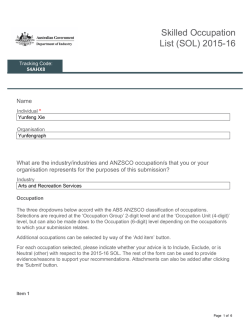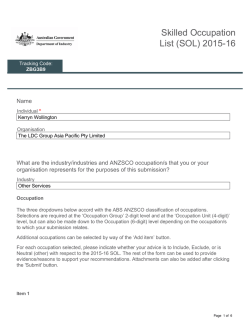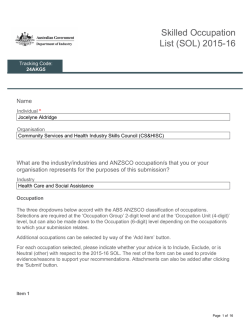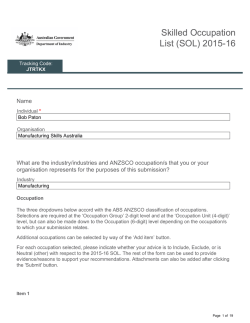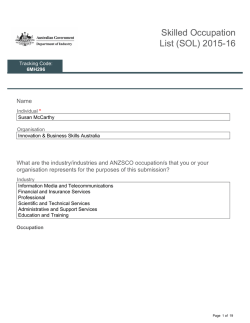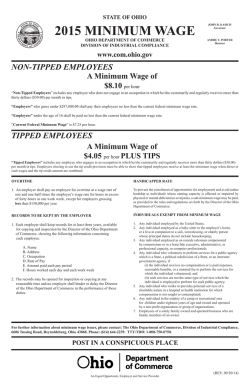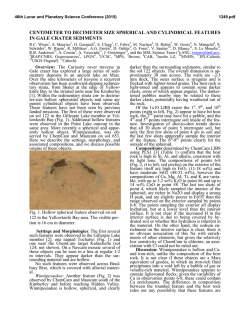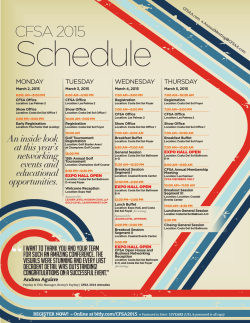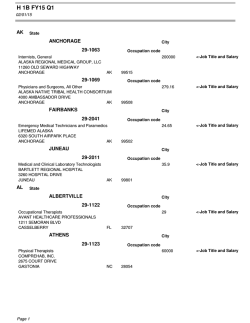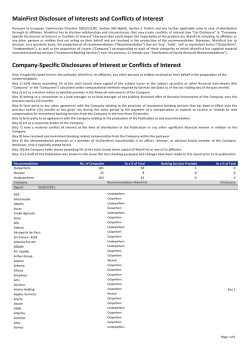
Skilled Occupation List (SOL) 2015-16
Skilled Occupation List (SOL) 2015-16 Tracking Code: 2YNQDY Name Individual * Megan Lilly Organisation Australian Industry Group What are the industry/industries and ANZSCO occupation/s that you or your organisation represents for the purposes of this submission? Industry Mining Manufacturing Electricity Gas Water and Waste Services Construction Transport Postal and Warehousing Information Media and Telecommunications Occupation Page 1 of 21 The three dropdowns below accord with the ABS ANZSCO classification of occupations. Selections are required at the ‘Occupation Group’ 2-digit level and at the ‘Occupation Unit (4-digit)’ level, but can also be made down to the Occupation (6-digit) level depending on the occupation/s to which your submission relates. Additional occupations can be selected by way of the ‘Add item’ button. For each occupation selected, please indicate whether your advice is to Include, Exclude, or is Neutral (other) with respect to the 2015-16 SOL. The rest of the form can be used to provide evidence/reasons to support your recommendations. Attachments can also be added after clicking the 'Submit' button. Item 1 Occupation Group * Specialist Managers Occupation Unit * Construction Managers Occupation Construction Project Manager 133111 Summary advice for 2015-16 SOL * Include Exclude Neutral Item 2 Occupation Group * Specialist Managers Occupation Unit * Engineering Managers Occupation Engineering Manager 133211 Page 2 of 21 Summary advice for 2015-16 SOL * Include Exclude Neutral Item 3 Occupation Group * Design, Engineering, Science and Transport Professionals Occupation Unit * Electrical Engineers Occupation Electrical Engineer 233311 Summary advice for 2015-16 SOL * Include Exclude Neutral Item 4 Occupation Group * Design, Engineering, Science and Transport Professionals Occupation Unit * Electronics Engineers Occupation Electronics Engineer 233411 Summary advice for 2015-16 SOL * Include Exclude Neutral Item 5 Page 3 of 21 Occupation Group * Design, Engineering, Science and Transport Professionals Occupation Unit * Industrial, Mechanical and Production Engineers Occupation Industrial Engineer 233511 Summary advice for 2015-16 SOL * Include Exclude Neutral Item 6 Occupation Group * Design, Engineering, Science and Transport Professionals Occupation Unit * Industrial, Mechanical and Production Engineers Occupation Mechanical Engineer 233512 Summary advice for 2015-16 SOL * Include Exclude Neutral Item 7 Occupation Group * Design, Engineering, Science and Transport Professionals Occupation Unit * Industrial, Mechanical and Production Engineers Occupation Production or Plant Engineer 233513 Page 4 of 21 Summary advice for 2015-16 SOL * Include Exclude Neutral Item 8 Occupation Group * ICT Professionals Occupation Unit * Telecommunications Engineering Professionals Occupation Telecommunications Engineer 263311 Summary advice for 2015-16 SOL * Include Exclude Neutral Exclude Neutral Item 9 Occupation Group * Construction Trades Workers Occupation Unit * Plumbers Occupation Roof Plumber 334115 Summary advice for 2015-16 SOL * Include Item 10 Page 5 of 21 Occupation Group * Construction Trades Workers Occupation Unit * Plumbers Occupation Plumber (General) 334111 Summary advice for 2015-16 SOL * Include Exclude Neutral Exclude Neutral Item 11 Occupation Group * Construction Trades Workers Occupation Unit * Carpenters and Joiners Occupation Carpenter 331212 Summary advice for 2015-16 SOL * Include Item 12 Occupation Group * Construction Trades Workers Occupation Unit * Carpenters and Joiners Occupation Joiner 331213 Page 6 of 21 Summary advice for 2015-16 SOL * Include Exclude Neutral Exclude Neutral Exclude Neutral Item 13 Occupation Group * Construction Trades Workers Occupation Unit * Carpenters and Joiners Occupation Carpenter and Joiner 331211 Summary advice for 2015-16 SOL * Include Item 14 Occupation Group * Construction Trades Workers Occupation Unit * Glaziers Occupation Glazier 333111 Summary advice for 2015-16 SOL * Include Item 15 Page 7 of 21 Occupation Group * Construction Trades Workers Occupation Unit * Plasterers Occupation Fibrous Plasterer 333211 Summary advice for 2015-16 SOL * Include Exclude Neutral Exclude Neutral Item 16 Occupation Group * Construction Trades Workers Occupation Unit * Plasterers Occupation Solid Plasterer 333212 Summary advice for 2015-16 SOL * Include Item 17 Occupation Group * Construction Trades Workers Occupation Unit * Plumbers Occupation Airconditioning and Mechanical Services Plumber 334112 Page 8 of 21 Summary advice for 2015-16 SOL * Include Exclude Neutral Exclude Neutral Exclude Neutral Item 18 Occupation Group * Construction Trades Workers Occupation Unit * Plumbers Occupation Drainer (Aus) 334113 Summary advice for 2015-16 SOL * Include Item 19 Occupation Group * Construction Trades Workers Occupation Unit * Plumbers Occupation Gasfitter 334114 Summary advice for 2015-16 SOL * Include Item 20 Page 9 of 21 Occupation Group * Electrotechnology and Telecommunications Trades Workers Occupation Unit * Electricians Occupation Electrician (General) 341111 Summary advice for 2015-16 SOL * Include Exclude Neutral Item 21 Occupation Group * Electrotechnology and Telecommunications Trades Workers Occupation Unit * Electricians Occupation Electrician (Special Class) 341112 Summary advice for 2015-16 SOL * Include Exclude Neutral Item 22 Occupation Group * Electrotechnology and Telecommunications Trades Workers Occupation Unit * Airconditioning and Refrigeration Mechanics Occupation Airconditioning and Refrigeration Mechanic 342111 Page 10 of 21 Summary advice for 2015-16 SOL * Include Exclude Neutral Item 23 Occupation Group * Automotive and Engineering Trades Workers Occupation Unit * Sheetmetal Trades Workers Occupation Sheetmetal Trades Worker 322211 Summary advice for 2015-16 SOL * Include Exclude Neutral Item 24 Occupation Group * Automotive and Engineering Trades Workers Occupation Unit * Structural Steel and Welding Trades Workers Occupation Metal Fabricator 322311 Summary advice for 2015-16 SOL * Include Exclude Neutral Item 25 Page 11 of 21 Occupation Group * Automotive and Engineering Trades Workers Occupation Unit * Structural Steel and Welding Trades Workers Occupation Pressure Welder 322312 Summary advice for 2015-16 SOL * Include Exclude Neutral Item 26 Occupation Group * Automotive and Engineering Trades Workers Occupation Unit * Structural Steel and Welding Trades Workers Occupation Welder (First Class) (Aus) 322313 Summary advice for 2015-16 SOL * Include Exclude Neutral Item 27 Occupation Group * Automotive and Engineering Trades Workers Occupation Unit * Aircraft Maintenance Engineers Occupation Aircraft Maintenance Engineer (Avionics) 323111 Page 12 of 21 Summary advice for 2015-16 SOL * Include Exclude Neutral Item 28 Occupation Group * Automotive and Engineering Trades Workers Occupation Unit * Metal Fitters and Machinists Occupation Fitter (General) 323211 Summary advice for 2015-16 SOL * Include Exclude Neutral Item 29 Occupation Group * Automotive and Engineering Trades Workers Occupation Unit * Metal Fitters and Machinists Occupation Fitter and Turner 323212 Summary advice for 2015-16 SOL * Include Exclude Neutral Item 30 Page 13 of 21 Occupation Group * Automotive and Engineering Trades Workers Occupation Unit * Metal Fitters and Machinists Occupation Fitter-Welder 323213 Summary advice for 2015-16 SOL * Include Exclude Neutral Item 31 Occupation Group * Automotive and Engineering Trades Workers Occupation Unit * Metal Fitters and Machinists Occupation Metal Machinist (First Class) 323214 Summary advice for 2015-16 SOL * Include Exclude Neutral Item 32 Occupation Group * Design, Engineering, Science and Transport Professionals Occupation Unit * Chemical and Materials Engineers Occupation Chemical Engineer 233111 Page 14 of 21 Summary advice for 2015-16 SOL * Include Exclude Neutral Item 33 Occupation Group * Design, Engineering, Science and Transport Professionals Occupation Unit * Chemical and Materials Engineers Occupation Materials Engineer 233112 Summary advice for 2015-16 SOL * Include Exclude Neutral Item 34 Occupation Group * Design, Engineering, Science and Transport Professionals Occupation Unit * Civil Engineering Professionals Occupation Civil Engineer 233211 Summary advice for 2015-16 SOL * Include Exclude Neutral Item 35 Page 15 of 21 Occupation Group * Design, Engineering, Science and Transport Professionals Occupation Unit * Civil Engineering Professionals Occupation Structural Engineer 233214 Summary advice for 2015-16 SOL * Include Exclude Neutral Item 36 Occupation Group * Design, Engineering, Science and Transport Professionals Occupation Unit * Civil Engineering Professionals Occupation Transport Engineer 233215 Summary advice for 2015-16 SOL * Include Exclude Neutral Item 37 Occupation Group * Specialist Managers Occupation Unit * Construction Managers Occupation Project Builder 133112 Page 16 of 21 Summary advice for 2015-16 SOL * Include Exclude Neutral Are there any occupations that you represent where there is evidence of imbalances in the demand for and supply of skills in the medium-to-long term? * Construction: all construction trades and construction-related engineering occupations should remain on the Skilled Occupation List. After a lengthy period of lower activity levels in 2012-13, activity in housing and commercial construction has been expanding In 2014 and is expected to continue to expand in 2015, as the construction cycle swings up again. Mining related engineering construction activity has declined in 2014 as several large projects reach completion in WA and Qld, freeing up some construction workers for other projects. Residential and commercial construction is, however, far more labour-intensive than engineering construction and is spread more evenly across the Australian states and regions. Pockets of skill shortage are expected to grow rapidly in some selected locations, particularly in and around Sydney, which is already experiencing heightened building activity in 2014. Ai Group receives regular updates on skills shortages and labour hire difficulties in the construction sector through our half-yearly Construction Outlook survey. During the six months to September 2014, close to half (45.7%) of commercial construction businesses reported major or moderate difficulty in the recruitment of skilled labour. This was a lower proportion than six months ago (58.1%) but still represents a large portion of the industry. The sourcing of subcontractors was also an important supply constraint in the six months to September 2014, with 34.3% citing major or moderate difficulty in hiring sub-contractors (compared to 38.7% six months ago). Source: http://www.aigroup.com.au/portal/site/aig/constructionoutlook Each month, Ai Group conducts performance surveys for the manufacturing, services and construction sectors (the Australian PMI®, PSI® and PCI®). The Australian PCI® has indicated expansion in total construction industry activity since June 2014, mainly due to a pick-up in residential construction. Increases in residential and commercial construction forward orders in the Australian PCI® are expected to underpin stronger labour demand in the building industry in 2015, despite ongoing decline in mining related engineering construction activity. Source: http://www.aigroup.com.au/economicindicators Page 17 of 21 Manufacturing: the department may wish to consider conducting further research into long-term future demand for automotive trades and automotive engineering occupations, for the purposes of the Skilled Occupation List. All other manufacturing-related occupations should remain on the Skilled Occupation List. In aggregate, the Australian PMI® has indicated slower wage growth and weak or contracting labour demand since at least early 2013, reflecting weak labour demand in some parts of manufacturing, as well as lower background inflation. There is considerable restructuring going on at present within manufacturing that is causing some sectors to decline, while others are growing. In metal products, automotive production and related machinery and equipment manufacturing, a pattern of contraction has been evident over the past three years, with reductions in output, sales, investment and demand for skilled labour. This weaker demand trend is likely to continue over the medium term, with the automotive production sector expected to be heavily affected by the scheduled closure of Australian passenger car assembly from 2017, combined with the effects of the higher Australian dollar, plus changes in global supply patterns for automotive parts and assembly. The special and unique conditions that now affect the outlook for automotive production in Australia are discussed in more detail at question 6 below. Outside the automotive supply chain, labour demand remains robust in other manufacturing sectors. Sustained growth is evident in the production of food, beverages, pharmaceuticals, medical appliances, cosmetics, toiletries, healthcare products and specialist machinery and equipment manufacturing (e.g. those with specialist mining or hydrology applications). These sectors are experiencing steady growth and are increasing their demand for skilled workers in chemistry, engineering, IT, production, marketing and related occupations. Demand remains solid for industrial, chemical and production engineers with experience or skills for these industries, or for engineers who are willing to move into these indsutries. Source: http://www.aigroup.com.au/economicindicators Is there evidence of imbalances in the demand for and supply of skills in the medium-to-long term in non-metropolitan areas? If so, can you indicate in what part of Australia and the number in the occupation in over or undersupply. Ai Group has received anecdotal evidence that demand for skilled trades has declined in some regional areas that host large-scale mining related engineering construction activity (e.g. northern WA) and/or the automotive manufacturing industry (e.g. North Adelaide and Geelong). Page 18 of 21 In contrast, demand for construction trades is strengthening in areas that are experiencing a strong pick-up residential building activity, primarily in and around Sydney. Are there any occupations which require formal licensing or registration arrangements in order to practice/perform in this occupation? For example: • Midwives are required to register with the nurses board in their state or territory • Panelbeaters are required to be registered or certified with the state Motor Vehicle Repair Industry Authority A number of the trade occupations listed above require formal licensing or registration. Is it expected that your employment sector will be impacted by any medium-to-long term trends which will impact upon demand and/or supply (excluding costs associated with training, labour hire, and international sponsorship)? Please provide evidence (e.g. data source, policy document) which substantiates these claims. For example: • New benchmarks for childcare centres mandate increased staff-to-child ratios and higher qualification standards for childcare workers. Since the SOL was last reviewed in 2014, the three international companies that assemble passenger cars in Australia - GMH Holden, Ford and Toyota - have all confirmed that they will cease to assemble cars in Australia by, or before, 2017. This decision will have a dire impact on the Australian automotive manufacturing industry over the next few years. The Productivity Commission estimates that up to 40,000 people will lose their jobs as a result of the closure of the major car assembly plants, including all production workers in the assembly plants plus many more in the automotive parts businesses that form their local supply chain. Based on our close and detailed knowledge of this industry, Ai Group and the FAPM believe that a total of at least 50,000 jobs will be lost as a direct result of the end of automotive assembly. A study conducted in 2013 by the National Institute for Economic and Industry Research (NIEIR) of Adelaide estimated that the end of Australian automotive assembly will result in a total 200,000 fall in national employment, due to large flow-on effects to other sectors and industries including other manufacturing sectors, engineering services, professional services and localised Page 19 of 21 education, health and consumer services (that is, when second-round or subsequent demand effects are added to the direct employment losses). All of these sources agree that the majority of automotive job losses will occur in Victoria and South Australia, with especially heavy losses for workers living in and around Geelong, Broadmeadows, Dandenong, North Adelaide and Elizabeth. Other segments of transport manufacturing and assembly are expected to be largely unaffected by this event, including trains, buses, trucks, caravans, trailers and campervans. These relatively smaller segments of transport manufacturing (compared to automotive) are growing at a slow but steady rate. They will continue to require specialist mechanics and engineers for their production facilities. Please provide any other information you consider relevant evidence to support your submission For example, you may know of some independent studies about your occupation that supports your advice to us. The Housing Industry Association (HIA) forecasts that Australia will need to build an average of around 186,000 dwellings per year (compared to 182,000 over the year to June 2014) between now and 2050, based on current ABS scenarios for medium population growth projections and real income growth rates. This very strong underlying demand for housing is due to ongoing population and incomes growth, combined with pent-up demand for new housing in some locations. This upward pressure is part of a well-documented and fairly predictable long-term demand cycle in the Australian housing market. It will continue to drive demand for skilled labour In the residential construction industry in the medium to long term. Would you like to make any additional comments on the SOL? The special conditions affecting the Australian automotive assembly industry over the next few years may require additional investigation by the department, for the purposes of the Skilled Occupation List. The department should closely examine all available evidence for future demand for these occupations before it makes any recommendations, so as to ensure there are no adverse consequences for other Australian industries that will require automotive-related skills or experience (e.g. in automotive parts manufacturing or in the manufacture and assembly of other transport equipment such as trucks, buses and trains). Page 20 of 21 Please provide the name, position and contact details of a person within your organisation who is willing to be contacted if any further information or follow-up is required. Name * Megan Lilly Position * Director, Education and Training Policy Contact details * T: (03) 9867 0163 M: 0418 102 119 E: [email protected] All information, including name and address details, contained in submissions will be made available to the public on the Department of Industry website unless you indicate that you would like all or part of your submission to remain in confidence. Automatically generated confidentiality statements in emails do not suffice for this purpose. Respondents who would like all or part of their submission to remain in confidence should provide this information in an email to SOL@industry. gov.au . Legal requirements, such as those imposed by the Freedom of Information Act 1982, may affect the confidentiality of your submission. Page 21 of 21
© Copyright 2025
